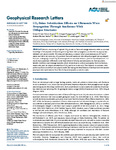CO2-Brine Substitution Effects on Ultrasonic Wave Propagation Through Sandstone With Oblique Fractures

Use este enlace para citar
http://hdl.handle.net/2183/37811Colecciones
- Investigación (ETSECCP) [826]
Metadatos
Mostrar el registro completo del ítemTítulo
CO2-Brine Substitution Effects on Ultrasonic Wave Propagation Through Sandstone With Oblique FracturesAutor(es)
Fecha
2020Cita bibliográfica
Falcon-Suarez, I. H., Papageorgiou, G., Jin, Z., Muñoz-Ibáñez, A., Chapman, M., Best, A. I. (2020). CO2-Brine Substitution Effects on Ultrasonic Wave Propagation Through Sandstone With Oblique Fractures. Geophysical Research Letters, 47(16). https://doi.org/10.1029/2020GL088439
Resumen
[Abstract:] Seismic monitoring of injected CO2 plumes in fractured storage reservoirs relies on accurate knowledge of the physical mechanisms governing elastic wave propagation, as described by appropriate, validated rock physics models. We measured laboratory ultrasonic velocity and attenuation of P and S waves, and electrical resistivity, of a synthetic fractured sandstone with obliquely aligned (penny-shaped) fractures, undergoing a brine-CO2 flow-through test at simulated reservoir pressure and temperature. Our results show systematic differences in the dependence of velocity and attenuation on fluid saturation between imbibition and drainage episodes, which we attribute to uniform and patchy fluid distributions, respectively, and the relative permeability of CO2 and brine in the rock. This behavior is consistent with predictions from a multifluid rock physics model, facilitating the identification of the dispersive mechanisms associated with wave-induced fluid flow in fractured systems at seismic scales.
Palabras clave
Ultrasonic waves
Electrical resistivity
Fractures
CO2 storage
Electrical resistivity
Fractures
CO2 storage
Versión del editor
Derechos
Atribución 3.0 España






